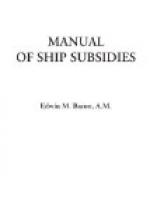The measure met opposition at the session in which it was first introduced; but at the next session (1898), after amendment, it became law. By this act the subsidy was fixed at one million and a half marks a year for the extension of the East Asiatic service to China direct, and for making the whole service fortnightly; and the contract was extended for another fifteen years. It was conditioned that if foreign competing lines should increase the speed of their ships the North German Lloyd must do likewise, and without additional subsidy, unless the foreign companies should receive extra payments.[CR]
The total annual subventions for the Asiatic and Australian service had now reached five million five hundred and ninety thousand marks ($1,330,420). After January, 1899, under a contract between the North German Lloyd and the Hamburg-American Line then made, a part of this subsidy went to the latter. In 1901 the subvention to the East African line was increased to one million three hundred and fifty thousand marks. Thus Germany’s grand total of annual payments in postal subventions had reached six million nine hundred and forty thousand marks.
Besides these postal subventions and the free entry to materials used in ship-construction and equipment, and the preferential railway rates on long hauls of the heavy domestic materials, barely covering the cost of handling and transportation,[CS] the Government bestows a special form of indirect bounty upon the subsidized steamship lines in the shape of largely reduced through freight rates. These include substantial reductions on merchandise exported from inland Germany to East Africa and the Levant. Thus the combined land and sea through rates are brought considerably below those in force on goods sent to German ports for direct importation.[CT]
Under these and other favoring conditions the German merchant marine has advanced in total tonnage from an insignificant place in 1880 to the third in rank among the maritime nations in 1911. Between 1885 and 1900, a period of only fifteen years, its growth was tenfold.[CU] In 1890 the gross tonnage stood at 928,911 tons: in 1900 it had reached a total of 2,159,919 tons. Steamers and sailing-ships were nearly equal in tonnage. German-built steamships had won the speed record in ocean liners. Thereafter the output of steamships became much the larger, and in 1906 the Government was taking measures to revive the sailing-ship trade, because of its value as a training-school for seamen for the navy.[CV] In 1910-11 the total tonnage was recorded at 4,333,186 tons.[CW]




